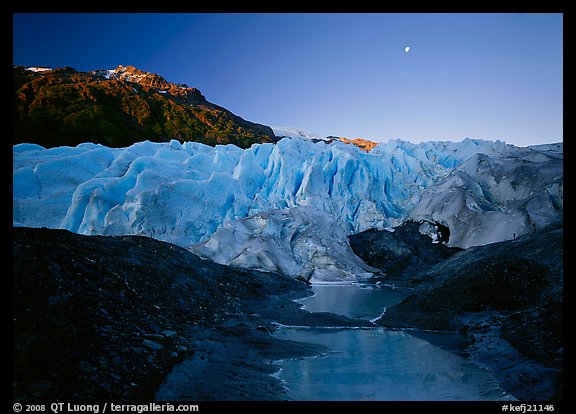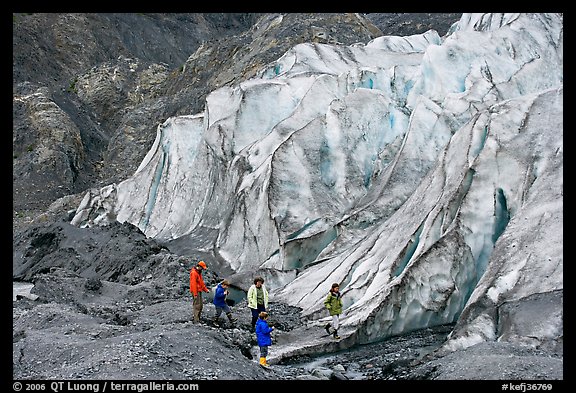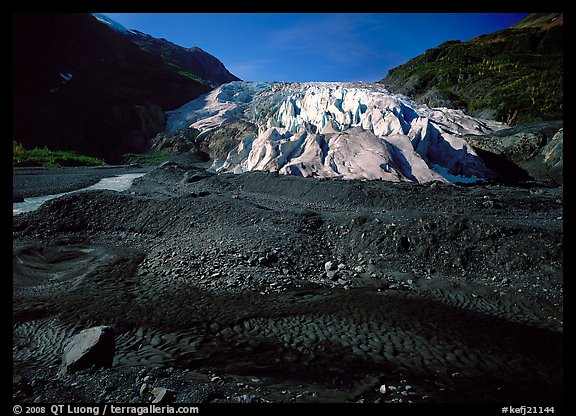Exit Glacier, Kenai Fjords National Park: Best Place Anywhere to Witness Glacial Retreat?
One Comment
The combination of easy access, interpretive signage, and dramatic change makes Exit Glacier in Kenai Fjords National Park possibly the best place in the world to witness glacial retreat with your own eyes. This is an account of the changes I saw in my four visits to Exit Glacier from 2001 to 2016.

Exit Glacier is one of the most easily accessed glaciers in Alaska. After a 12-mile drive out of Seward, a pleasant city with plenty of amenities, you walk on a good trail to the edge of the glacier. The walk is getting longer as the glacier is retreating, but in 2016, it was only about a mile each way. The approach road and trail are punctuated with signs that indicate the position of the glacier terminus over the years.

Edge of the Glacier
After a 0.3-mile paved section, the trail splits. The well-maintained upper Edge of the Glacier Trail climbs the moraine, offering a view from above of a wall of blue ice fractured by crevasses and seracs. Because you are a bit higher, the perspective let you take the size of the glacier.

Exit Glacier, Edge of the Glacier Trail, 2000
I first visited Exit Glacier in 2000 when it was indeed possible to walk right to the edge of the ice.

Exit Glacier, Edge of the Glacier Trail, 2006
Returning in 2002, I looked for the spot where I had made the photograph in 2002, but noticed that the ice would have been too far to photograph the reflexion. In 2006, the glacier had retreated much further, but the terminus still ended on the plain, with a final slope that was gentle enough to make approaching the wall of ice safe.

Exit Glacier, Edge of the Glacier Trail, 2016, standing at the 2010 terminus point
I last visited Exit Glacier in the fall of 2016. Although I was expecting to see changes, I couldn’t believe my eyes when I got to the end of the trail. It was enclosed by fence lines to prevent visitors from continuing further since the terrain beyond is a closed area, as it was too steep to be safe. Standing there, I was separated from the glacier by a distance of hundreds of yards. Yet a sign showed that the glacier reached this point in 2010. The glacial retreat had clearly been accelerating.

Exit Glacier terminus, Sept 10, 2016
In the late afternoon, Exit Glacier is in the shade, and under those conditions, the ice takes its characteristic blue tint. Water flowed out of the glacier from underneath an intriguing free-standing ice arch, and carried out icebergs. I immediately wanted to get closer.

Outwash plain from Edge of Glacier
Looking in the opposite direction revealed the deep gorge uncovered by Exit Glacier over the last decade, which nowadays is the only route that takes you closer.
Toe of the Glacier route

Exit Glacier, Toe of the Glacier route, 2000
The lower Toe of the Glacier route (not a set trail) crosses the rocky outwash plain of dark rock, which provides a striking contrast with the ice. During my previous visits, I was able to make my way to the terminus of the glacier to see it from below without getting my feet wet. The glacial stream meandered lazily on the glacial plain.

Exit Glacier, Toe of the Glacier route, 2016
In 2016, you had to go past the narrow gorge uncovered by glacial retreat. There is much less room in the gorge, and the stream is flowing right at the edge of the gorge’s wall. To come closer to the ice, I had to cross the glacial streams several times, the first one being right where the maintained trail exits the woods. As you can guess, the water was ice-cold. I was glad that I came well-prepared, wearing chest waders.

Exit Glacier, Toe of the Glacier route, 2016
Moreover, the flow was much stronger. Even in knee-depth water, the force of the flow worried me. I definitively needed my hiking poles for the crossing. Even without listening to the stream’s roar, you can tell its power from the fact that it is now carrying icebergs, which I never saw in my visits of a decade ago.

Exit Glacier terminus, Sept 11, 2016
Since the terminus of the glacier is now much steeper than before, the danger posed by falling ice is considerably higher. If a block of ice was to detach itself further high, it could roll down quite a ways. Although there are no signs nor fences there, I stayed at a respectful distance from the terminus. It didn’t take long for the glacier to change. The free standing arch that intrigued me the day before had already collapsed the next day!
Autumn in Alaska: Part 4 of 9: 1 | 2 | 3 | 4 | 5 | 6 | 7 | 8 | 9


I am in awe of these pictures which I came across just by following a travel site trail. Because of infirmities and age I will never see these wonders in person. Thank you for sharing your outstanding skills and braveness. Thank you for giving us your wonderful world of pictures and words which brought me great joy.